Evaluation of the Effective Components in the Survey of Types of Liquefaction
Hadi Shahrokhifard1 * and Seyed Jamal Poursalehan2
1
Department of Civil Engineering,
Tehran,
Iran
2
Department Young Researchers Club,
Behbahan Branch,
Islamic Azad University,
Behbahan,
Iran
Corresponding author Email: It_shahrokhi_fard@yahoo.com
DOI: http://dx.doi.org/10.12944/CWE.10.Special-Issue1.42
Occurrence of liquefaction in saturated sandy soils with low density is possible. During an earthquake with the vibratory forces applied to the soil, tendency to reduce the volume causes pore water pressure to increase. Provided that this increase of pressure is continued so that the effective stress reaches zero under the equivalence with total stress, the soil would lose its loading power and in bearing higher loads, it acts as if it is condensed liquid, the result of which would be settlement, rotation and huge marginal displacements which could be easily sunken in the ground. The purpose of this article is to evaluate the possible liquefaction is caused by the earthquake induced forces. Results indicate that the decrease of resultants in strength and rigidity, causes Thrust shear stresses to operate in the direction of differentiating shear forms which would ultimately lead to Swelling of the soil and thus the reduction pore pressure.
Copy the following to cite this article:
Shahrokhifard H, Poursalehan S. J. Evaluation of the Effective Components in the Survey of Types of Liquefaction. Special Issue of Curr World Environ 2015;10(Special Issue May 2015). DOI:http://dx.doi.org/10.12944/CWE.10.Special-Issue1.42
Copy the following to cite this URL:
Shahrokhifard H, Poursalehan S. J. Evaluation of the Effective Components in the Survey of Types of Liquefaction. Special Issue of Curr World Environ 2015;10(Special Issue May 2015). Available from: http://www.cwejournal.org/?p=10231
Download article (pdf)
Citation Manager
Publish History
Select type of program for download
| Endnote EndNote format (Mac & Win) | |
| Reference Manager Ris format (Win only) | |
| Procite Ris format (Win only) | |
| Medlars Format | |
| RefWorks Format RefWorks format (Mac & Win) | |
| BibTex Format BibTex format (Mac & Win) |
Article Publishing History
| Received: | 2014-11-20 |
|---|---|
| Accepted: | 2015-12-30 |
Introduction
Liquefaction is a phenomenon in which deformation of non-cohesive saturated soils happens in untrained conditions affected by transient, monotonous or repetitive disturbances. In this phenomenon, saturated soils thoroughly lose their strength and rigidity due to the heavily inflicted stress. This stress can be owing to rapid changes in the stress status of soils. This issue is frequently reported in saturated soils, limp soils (low density or not concentrated), and sandy soils. The above issue is because limp soils tend to compress under loads while compressed soils tend to increase their volume. If soil is saturated with water, as in soils of sea levels or lower, then water would fill the space between solid grains (porous spaces). Now, if a pressure is inflicted to soil, it is inflicted to the water of porous spaces as well, forcing water to exit soil porous spaces and moving towards less pressured spaces. However, if the pressure is inflicted fast enough and it is big enough or it is done with enough repetitions (as in earthquakes or inflicted during hurricanes) so that the water would not be allowed leave the inter grain spaces until the next cycle, a pressure will be created in the water that is extremely greater than the stress which causes the soil grains to stick together. When the soil loses its structure as mention and the contact between solid grains are destroyed, it shows no strength inside (losing its capability to transfer shear stress) and acts as a fluid. In soil mechanics the term "liquefied" was first used by Hazen in reference to the 1918 failure of the Calaveras Dam in California.
Definition of Liquefaction
A state of 'soil liquefaction' occurs when the effective stress of soil is reduced to essentially zero, which corresponds to a complete loss of shear strength. This may be initiated by either monotonic loading (e.g. single sudden occurrence of a change in stress – examples include an increase in load on an embankment or sudden loss of toe support) or cyclic loading (e.g. repeated change in stress condition – examples include wave loading or earthquake shaking). In both cases a soil in a saturated loose state, and one which may generate significant pore water pressure on a change in load are the most likely to liquefy. This phenomenon has more destructive power in areas close to water such as rivers, lakes, bays and oceans. The effects of this phenomenon in areas close to water include major soil slide towards the coast and its settlement as in lake Morcid in 1957, or landslide and cracks in beaches due to the extra stress as in Motagua river in 1976 Guatemala earthquake. Damages to ports’ holding walls and dock by inflicting pressure in their supporting soil and moving them towards water are other damages that liquefaction can cause near-coastal areas, as is illustrated in figure 1.
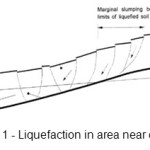 |
Figure1: Liquefaction in area near coasts |
The history of researches undertaken in occurring liquefaction indicates that, many studies on sandy soils and particle soils and silts and Clayey silts and even sands with sub particles are not considered to have the ability to liquefy. Considering the behavior of soil under poorly drained stress and according to the results obtained from studies by Robertson (1994) and Robertson and Fier (1995), different types of liquefaction can be defined as the following.
Types of Liquefaction
Marginal changes of form in earth is caused by liquefaction in earth made of saturated sandy soils and it is considered to be one of the most important factors of damaging during the process of liquefaction due to marginal expansions. These changes are permanent and their size vary from mere centimeters to some meters in some cases (Mirhosseini et al., 1993).
A- Flowing liquefaction
It is a phenomenon in which the static balance of Sedimentary soils with residual resistance is unbalanced due to the static or dynamic loads, meaning that the residual resistance of soil is liquefied. For instance, a static load can inflict extra force to the soil of foundation in a new structure built on slope. Explosions and pilings are examples of dynamic loads that can cause liquefaction. Also after the first occurrence of liquefaction in soil, the soil would become more likely to have further liquefactions, as the soil wouldn’t have the required resistance to tolerate the static stresses as before the turbulences shown in figure 2.
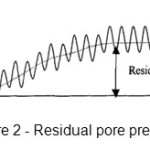 |
Figure2: Residual pore pressure |
- Flowing liquefaction is exclusive to soils that are in the Strain softening condition.
- Flowing liquefaction requires response from Strain softening under poorly drained loading, a condition which would lead to shear stress and constant effective stress.
- Flowing liquefaction requires in situ shear stresses with values greater than the initial or final undrained shear stresses.
- Both the unilateral and intermittent loading can lead to flowing liquefaction.
- To break a soil structure such as Gable roofs, enough volume of material should be in straining condition. Depending on the characteristics of the material and the geometry of land, the resulting failure could be slide or flow (Seed et al., 1995). Occurred changes of locations are due to internal factors and could happen after the moving mechanism of liquefaction.
Flowing liquefaction can occur in any saturated soil with low stability such as loose granular sediments, clays, silt clays and sensitive sediments. Generally, the signs of flowing liquefaction are:
Sudden occurrence, rate of spread and long distances of material movements.
B- Cyclic Softening
Cyclic softening occurs in both soil softening and strain hardening. In the study of this phenomenon two terms can be used: cyclic liquefaction and cyclic mobility.
B- 1- Cyclic Liquefaction
Cyclic liquefaction requires undrained cyclic loadings, in which the bilateral shear stresses occurs with creating zero shear stress. In other words, cyclic liquefaction occurs when in situ static shear stresses are small compared to intermittent shear stresses.
- Cyclic liquefaction requires undrained cyclic loadings so that it occurs in zero effective stress conditions.
- During the cyclic liquefaction, effective stress at point zero, there is no shear stress. Occurs when the shear stress due to the tendency to expansion, pore water pressure drops, but it may be a very soft stress-strain response of which can lead to large deformations will occur.
- During liquefaction periodic, cyclic loading deformations can be piled up a lot, but usually loaded with periodic stops to reach steady state. Change places, there are dependent on external factors and only occurs when the load is periodic.
- Periodic liquefaction can occur almost in all of saturated sandy soils under cyclic loading with sufficient magnitude and duration. Figure 3 shows observable intermittent liquefaction vividly.
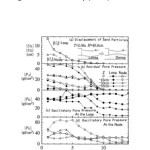 |
Figure3: Oscillatory pore pressure |
Clayey soil liquefaction may experience periodic deformations but the adhesion strength at zero effective stress will be small. In most cases, the rate of change (creep), controls Deformation in cohesive soils.
B- 2- Cyclic Displacement
Periodic mobility needs of Undrained cyclic loading during which the shear stresses are always greater than zero, it is (i.e. not a two-way shear stress).
During the periodic motion, zero effective stress does not happen.
During the periodic motion, deformations during periodic steady state will be loaded. Places the result depends on external factors and only occur when there is a cyclic loading.
Saturated sand under cyclic loading in almost any rotational movement of sufficient magnitude and duration, can occur. But no double shear stress does not occur.
Cohesive soils can also have a periodic motion but usually controls Creep Deformation
It should also be noted that strain softening soils (cyclic liquefaction or cyclic mobility), will experience that this is dependent on the geometry of the ground that showed in figure 4.
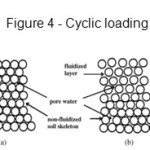 |
Figure4: Cyclic loading |
The first step is to evaluate the properties of the material that is used to evaluate liquefaction according to the above definitions, the process proposed in the year (1944), two types of response to strain softening and strain hardening response is divided. If the soil is strain softening properties, if the impact (excitation), have the ability to collapse, and also carry shear stresses greater than the minimum resistance or final, flow liquefaction will be possible. Mechanism of action may be in the form of periodic or one-sided.
Failure or slide of a gable roof or a soil structure depends on the ratio of strain softening soil to strain hardening soil within the structure, friability of the strain softening soil, and the geology of land. Change of the formation within soil structures made from strain hardening soil and strain softening soils depends on various factors such as the distribution of soil (hard or soft), the geology of land, the amount and mechanism of action, friability of the strain softening soil and drainage conditions (Gatmiri et al., 2004).
Soils that are only put in the strain softening condition temporarily (i.e. experiencing a minimum resistance before dilatation till final condition), are not as dangerous as loose soils which can directly reach final point in softening condition. If the soil is in strain hardening conditions, flow liquefaction usually wouldn’t occur. Although it is possible that under the effect of cyclic undrained loading such as seismic loading, cyclic softening takes place. The direction and amount of deformation during cyclic loading depends on the density of soil, size and duration of cyclic loading, domain and range of two-sidedness of shear stress. Provided that this two-sidedness of shear stress is coupled with great domain, it is possible that effective stresses reach zero and thus cyclic liquefaction occurs. In figure 5, the condition of zero effective stress can lead to major deformations. If the cyclic loading is persisted, deformations can increase with a progressive manner. If the two-sidedness of shear stress doesn’t occur, it is not normally possible to reach an effective stress equivalent of zero and the deformations will be smaller, therefore emerging cyclic mobility. In case of liquefaction and blockage of drainage routes due to the existence of upper layers with lower Permeability, it is possible that the sands below this layers are loosened due to the openness of the pressure of pore water distribution, and provided the existence of susceptible geometry, it can lead to occurrence of flow liquefaction (Kramer, 1996).
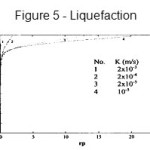 |
Figure5: Liquefaction |
Both flow and cyclic liquefaction can cause massive deformations. Hence, identifying the exact type of phenomenon based on the observations of deformations is very hard to do. Displacements resulted from flow liquefaction have a tendency to persist because of the progressive nature of load distribution, even after the cyclic loading has stopped. But if the soil is loose enough and shear stresses are big, there is this probability that seismic loading in early cycles of loading lead to natural liquefaction (Seed et al., 1983). Also, if the soil is loose, it is possible that undrained final resistance and corresponding limiting effective stress would be very close to zero (Bargy, 2000). On the other hand, cyclic liquefaction displacements occur during cyclic loading because the internal forces are the occurrence factor of these displacements. Many researches on liquefaction are closely related to cyclic softening and in particular, cyclic liquefaction (Seed et al., 1994).
The reaction of seabed soil to the progressive waves of water, have an important role in the analysis and design of sea structure. A major part of this reaction which is observable in non-cohesive sediments was due to the extra pore pressure which was generated in the soil and due to the periodic activity of waves. Near coast and farther from billows where waves are more stable and the water is shallow, the seabed is under significant dynamic pressure due to activity of passing waves. Such pressure causes periodic stress in soil and may lead to the gradual increase of pore pressure. Pore pressure can, to some extent, increase with the initial vertical effective stress and cause initial liquefaction (Shahrokhifard et al., 2014).
C - Surface Liquefaction
One specific type of liquefactions are cyclic liquefactions. In these liquefaction, rupture is owning to the upward flow during Depreciation of pore water pressure in an earthquake. Type of liquefaction is possible to occur after earthquakes and by reaching hydraulic balance. Sign of surface liquefaction are: vertical settlement and consequent floods in lowlands and fermentation of sands.
Selection of Independent Parameters Affecting of Liquefaction Potential
In the previous analysis assessing potential of liquefaction, it was assumed that soil wasn’t drained in earthquake. Such an assumption would be conservative as generation and removal of porous pressure would be simultaneous (Schofield et al., 2000).
Potential of liquefaction implies that by generating and maintaining high porous pressure from water, soil would be permanently deformed and tolerating effective stress would be reduced, and thus potential of liquefaction is related to extra porous water pressure. Kazagrande et al. tried to descript liquefaction mechanism in static loading. Vibration cyclic loading simulation was conducted by Seed and Edriss in University of Berkeley lab. Estimation of potential of liquefaction includes cyclic stress and number of cycle reoccurrence. This equivalent state has maximum of 100 percent pressure. For relative density over 40%, implementing high cyclic pressures with enough rounds for 100 percent of pressure only a small amount of strain would be resulted. For relative density lower than 40%, implementing high cyclic pressures with enough rounds for 100 percent of pressure very large amount or even infinite of strain would be resulted and thus the liquefaction would be resulted (Poulos, 1988).
Contributing factors to liquefaction potential are:
- Parameters related to earthquake: acceleration (maximum horizontal distance differential near earth surface and recorded by accelerometer) and intensity of earthquake on Richter scale which defines the energy of quake.
- Air bubbles confined among particles: existence of such bubbles will lead to lower chance of liquefaction.
- Characteristic of vibration loads: the landslide resulted due to horizontal vibration are more severe than vertical ones. Also, quake time length or in fact the amount of time which soil remains in liquid state is directly related to structural damage cause by liquefaction phenomenon (Taherpoor et al., 2014).
- Factors related to soil: total and effective pressure of soil are determinant on liquefaction and their differential resembles porous water pressure and level waters below surface.
- Permeability: as seen in figure 6 with decrease in soil permeability ratio, porous pressure will increase near the bank. In other words, expansion of porous pressure in bank is more uniform in soils with higher permeability. Notice that with decrease of permeability depth of liquefaction initially increases but with further decrease in permeability, the depth will slightly reduce. The relation between maximum liquefaction depth and soil permeability has been evaluated in different places far from shore. Results show that soil reaction described to wave loading time scale via porous pressure distribution scale. Under the same wave loading, a soil column far from shore can experience greatest liquefaction depth, but longest time of liquefaction (which can physically attributed to liquefaction volume) occurs in leakage area due to high loading pattern of that area (Gatmiri et al., 2004).
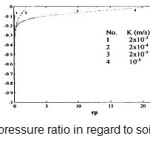 |
Figure6: Porous pressure ratio in regard to soil permeability variability |
- Sand pile formation time: untouched soil vs. constructed soil is 75 more resistant to liquefaction.
- Drainage effect: drainage (removal of extra porous pressure) after cyclic loading is mentioned in figure 7, and drainage changes soil responses to uniform stress variability and following cycles. The sign of residual porous pressure determines whether drainage has improved soil response or has worsen it. It can be stated that positive residual porous pressure removal, increase the critical limit of cyclic loading and improve soil response to cyclic loading.
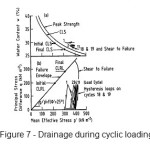 |
Figure7: Drainage during cyclic loading |
8. Sand pile initial relative density: as it is clear in figure 8, with increase in initial relative density of material, landslides and water porous pressure considerably decrease in vibration loading. Thus, with increase of relative density and sand congestion, chance of liquefaction occurring decrease. In methods which drainage is not considered (e.g. Nataraja & Gill) are less sensitive to relative density. Also for soil with low compressibility, non-drainage method result in much less liquefaction depth vs. drainage methods.
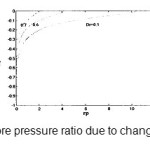 |
Figure8: Distribution of pore pressure ratio due to changes in relative density of soil |
9. Characteristic and amount of loading: implementing uniform stress on sand pile will lead to initial effective stress in soil which reduces the likelihood of liquefaction (http://i-plus.ir, 2013).
Nataraja & Gill described a method in 1983 which used standard permeability test (STP) for this, but a year later, Ishihara & Yamazaki utilized sand relative pressure to assess liquefaction resistance. Both method have the same basis, meaning in both shear stress for liquefaction is compared.
Fin et al. developed a method in 1977 which allowed to determine the quantity of porous water pressure and the effects of drainage and inner flow on position and timing of liquefaction. This analysis includes using of non-linear structural equations which determine following parameters: initial shear module in place, change of shear module with shear strain, generation and removal of porous pressure in the same time, changes in mean effective normal stress, attenuation and hardening.
In analytic and theoretical methods, liquefaction potential is determined by comparison between shear stress on soil element due to quake and tolerable earth shear stress. Wherever engineer calculates shear stress on soil element due to quake is more that earth can tolerate, liquefaction is considered likely.
Conclusion
Although earthquake increase porous water pressure, but construction related activities like explosion and generally change in earth reactionary stress via loading and unloading will lead to slide and destruction. Isolated soil liquefaction performance relating to quality of porous water pressure increment can be divided in 2 categories. First cyclic shear stresses in seabed due to quake and second liquefaction due to transient wave due to extra porous water pressure. With regard to results, earth shear deformation can be due to cyclic shear stress accumulated by quake. This cyclic accumulation of residual shear strain can describe physical mechanism of liquefaction due to earthquake.
- As a result of liquefaction, ground structures can be sunk of deform, lightweight structures are buried and change in foundation capacity of dynamic loads cause extra damage.
- Liquefaction on loose, saturated and non-adhesive sand can have severe consequences.
- Extensive damages due to liquefaction resulted by a previous quake should be analyzed and appropriate methods should be utilized in order to minimize destruction.
- Soil optimization method should be done in the right way.
- When normal effective stress is higher than soil pile submergible weight, liquefaction happens. However, this formula is not valid on non-adhesive soil due to lack of existence of lateral stress calculation. Furthermore, static pressure is less than wave load or normal stress.
References
- Bargy, Kh., "Fundamentals of Earthquake Engineering", Third Edition. Printing. Tehran, Iran: (Tehran University 2000).
- Gatmiri, B,. And Ashour, A., "Evaluation of the passing wave seabed liquefaction" Tehran University College of Engineering, 38 (2), 259-268 (2004).
- http://i-plus.ir (2013).
- Kramer, SL., “Geotechnical earthquake engineering”, Upper Saddle River, NJ: Prentice-Hall, (1996).
- Mirhosseini, S, M., "Soil Dynamics", Tehran, Iran: International Institute of Seismology and Earthquake Engineering publications, (1993).
- Poulos, H.G., “Marine Geotechnics”, (Unwin Hyman Ltd, 1988).
- Shahrokhifard, H,. and Jalili, M., "A study effects of height and period of waves on the Persian Gulf seabed liquefaction by cyclic loading wave", the first national conference on architecture, civil engineering and urban environment, Faculty ofShahid mofatteh, Hamedan, (2014).
- Schofield, A.N., and Muhunthan, B., "Liquefaction and dam failures". CUED/D-SOILSITR310-ASC Conference, GeoDenver (2000).
- Seed, H.B. Idriss, I.M. and Arango, I., “Evaluation of Liquefaction Potential Using Field Performance Data”, J. of Geotech. Eng, ASCE, 109(3), 458-482 (1983).
- Seed, H, B,. and Idriss, E, M., "The Land and Soil liquefaction during earthquakes", Tehran, Iran: International Institute of Seismology and Earthquake Engineering publications, (1995).
- Taherpoor, F,. and Zamani Lanjani, M., "Evaluation of liquefaction of soil types and ways to deal with it", First National Conference on Soil Mechanics and Foundation Engineering, Faculty of Engineering, Shahid Rajai teacher training a University of Tehran, (2014).






